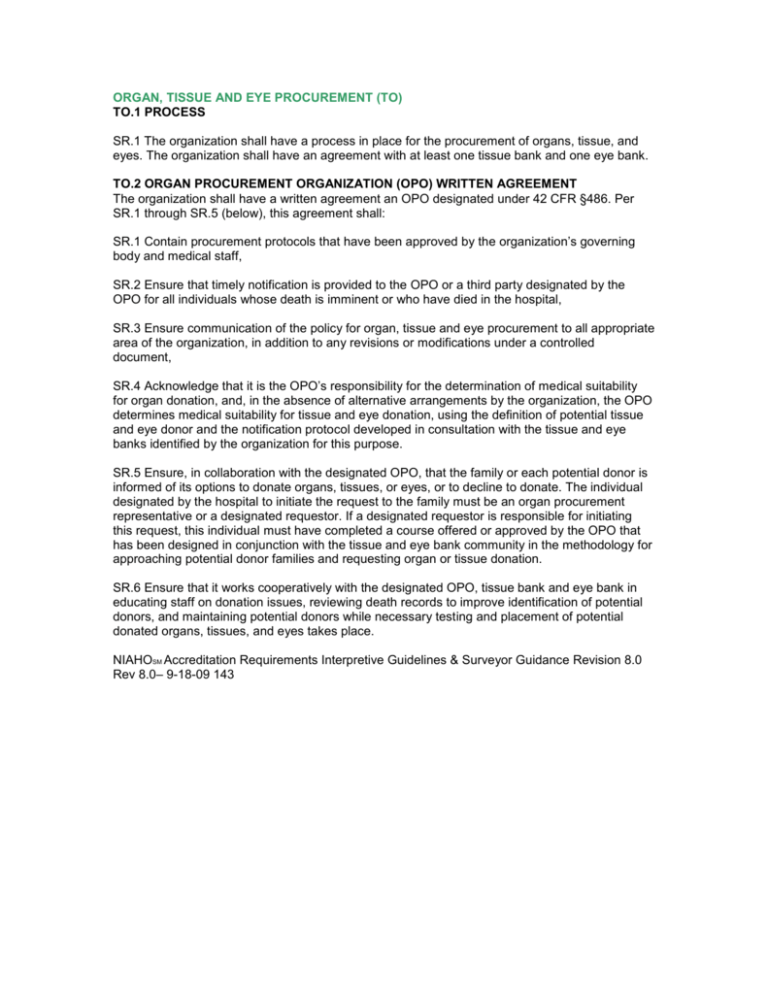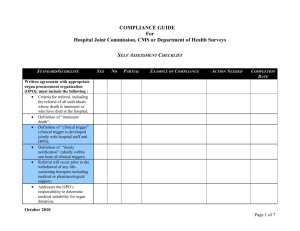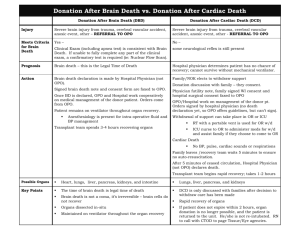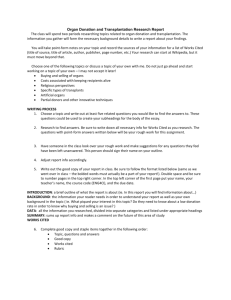DNV Organ and Tissue Standards
advertisement

ORGAN, TISSUE AND EYE PROCUREMENT (TO) TO.1 PROCESS SR.1 The organization shall have a process in place for the procurement of organs, tissue, and eyes. The organization shall have an agreement with at least one tissue bank and one eye bank. TO.2 ORGAN PROCUREMENT ORGANIZATION (OPO) WRITTEN AGREEMENT The organization shall have a written agreement an OPO designated under 42 CFR §486. Per SR.1 through SR.5 (below), this agreement shall: SR.1 Contain procurement protocols that have been approved by the organization’s governing body and medical staff, SR.2 Ensure that timely notification is provided to the OPO or a third party designated by the OPO for all individuals whose death is imminent or who have died in the hospital, SR.3 Ensure communication of the policy for organ, tissue and eye procurement to all appropriate area of the organization, in addition to any revisions or modifications under a controlled document, SR.4 Acknowledge that it is the OPO’s responsibility for the determination of medical suitability for organ donation, and, in the absence of alternative arrangements by the organization, the OPO determines medical suitability for tissue and eye donation, using the definition of potential tissue and eye donor and the notification protocol developed in consultation with the tissue and eye banks identified by the organization for this purpose. SR.5 Ensure, in collaboration with the designated OPO, that the family or each potential donor is informed of its options to donate organs, tissues, or eyes, or to decline to donate. The individual designated by the hospital to initiate the request to the family must be an organ procurement representative or a designated requestor. If a designated requestor is responsible for initiating this request, this individual must have completed a course offered or approved by the OPO that has been designed in conjunction with the tissue and eye bank community in the methodology for approaching potential donor families and requesting organ or tissue donation. SR.6 Ensure that it works cooperatively with the designated OPO, tissue bank and eye bank in educating staff on donation issues, reviewing death records to improve identification of potential donors, and maintaining potential donors while necessary testing and placement of potential donated organs, tissues, and eyes takes place. NIAHOSM Accreditation Requirements Interpretive Guidelines & Surveyor Guidance Revision 8.0 Rev 8.0– 9-18-09 143 Interpretive Guidelines: The hospital has a process in place for the procurement of organs, tissue, and eyes. The hospital must have a written agreement with an Organ Procurement Organization (OPO), designated under 42 CFR Part 486. At a minimum, the written agreement must address the following: Procurement protocols approved by the governing body and medical staff and criteria for referral, including the referrals of all individuals whose death is imminent or who have died in the hospital and ensure timely notification; Specifications as to how the tissue and/or eye bank will be notified about potential donors using notification protocols developed by the OPO in consultation with the hospital-designated tissue and eye bank(s); The OPO’s responsibility for the determination of medical suitability in lieu of any alternative arrangement with a different tissue and/or eye bank; Provisions for notification of each individual death in a timely manner to the OPO (or designated third party) in accordance with the terms of the agreement; Documentation that the designated requestor training program offered by the OPO has been developed in cooperation with the tissue bank and eye bank designated by the hospital; Procedures that permit the OPO, tissue bank, and eye bank access to the hospital’s death record information according to a designated schedule, e.g., monthly or quarterly; Policies that confirm that the hospital is not required to perform credentialing reviews for, or grant privileges to, members of organ recovery teams as long as the OPO sends only “qualified, trained individuals” to perform organ recovery; and, The interventions the hospital will utilize to maintain potential organ donor patients so that the patient organs remain viable. The hospital must implement a mechanism for communication of the policy for organ, tissue and eye procurement to all appropriate area of the organization, in addition to any revisions or modifications under a controlled document Hospitals must notify the OPO of every death or imminent death in the hospital. When death is imminent, the hospital must notify the OPO both before a potential donor is removed from a ventilator and while the potential donor’s organs are still viable. The hospital should have a written policy, developed in coordination with the OPO and approved by the hospital’s medical staff and governing body, to define “imminent death.” The definition for “imminent death” should strike a balance between the needs of the OPO and the needs of the hospital’s care givers to continue treatment of a patient until brain death is declared or the patient’s family has made the decision to withdraw supportive measures. Collaboration between OPOs and hospitals will create a partnership that furthers donation, while respecting the perspective of hospital staff. Definition elements: “Imminent death” might include a patient with severe, acute brain injury who: Requires mechanical ventilation; Is in an intensive care unit (ICU) or emergency department; AND, Exhibits clinical findings consistent with a Glascow Coma Score that is less than or equal to a mutually-agreed-upon threshold or MD/DOs are evaluating a diagnosis of brain death or NIAHOSM Accreditation Requirements Interpretive Guidelines & Surveyor Guidance Revision 8.0 Rev 8.0– 9-18-09 144 An MD/DO has ordered that life-sustaining therapies be withdrawn, pursuant to the family’s decision. Note: A patient with “severe, acute brain injury” is not always a trauma patient. For example, post myocardial infarction resuscitation may result in a patient with a beating heart and no brain activity. Definition: “Timely notification” means a hospital must contact the OPO by telephone as soon as possible after an individual has died, has been placed on a ventilator due to a severe brain injury, or who has been declared brain dead (ideally within 1 hour). That is, a hospital must notify the OPO while a brain dead or severely brain-injured, ventilator-dependent individual is still attached to the ventilator and as soon as possible after the death of any other individual, including a potential non-heart-beating donor. Even if the hospital does not consider an individual who is not on a ventilator to be a potential donor, the hospital must call the OPO as soon as possible after the death of that individual has occurred. The individual designated by the hospital to initiate the request to a family must be an organ procurement representative, an organizational representative of a tissue or eye bank, or a designated requestor. Any individuals involved in a request for organ, tissue, and eye donation must be formally trained in the donation request process. Definition: A “designated requestor” is defined as a hospital-designated individual who has completed a course offered or approved by the OPO and designed in conjunction with the tissue and eye bank community. Surveyor Guidance: Verify that the hospital has a written agreement, approved by the governing body, and that it addresses all required information. In a sampling of records, verify that the hospital has implemented its organ procurement policies. Verify that that all designated requestors have completed the required training. Verify that the hospital ensures that only OPO, tissue bank, or eye bank staff or designated requestors are approaching families to ask them to donate. When possible, interview a hospital-designated requestor regarding his or her approach to donation requests. Validate that the hospital ensures that all appropriate staff have attended an educational program regarding donation issues and how to work with the OPO, tissue bank, and eye bank. Review and verify that there are policies and procedures in place to ensure the coordination between facility staff and OPO staff in maintaining the potential donor. Verify that the organ, tissue, and eye procurement program is integrated into quality management system oversight. TO.3 ALTERNATIVE AGREEMENT In the event the organization has an alternative agreement with a tissue and/or eye bank, this agreement shall: SR.1 Specify the criteria for referral of all individuals who have died in the organization, and, SR.2 Acknowledge the OPO’s responsibility for the determination of medical suitability in lieu of any alternative arrangement with a different tissue and/or eye bank Surveyor Guidance: Verify that the hospital has an agreement with at least one tissue bank and one eye bank that specifies criteria for referral of all potential tissue and eye donors, or an agreement with an OPO that specifies the tissue bank and eye bank to which referrals will be made. NIAHOSM Accreditation Requirements Interpretive Guidelines & Surveyor Guidance Revision 8.0 Rev 8.0– 9-18-09 145 Verify that the OPO is responsible for the determination of medical suitability for tissue and eye donation, unless the hospital has an alternative agreement with a different tissue and/or eye bank. TO.4 RESPECT FOR PATIENT RIGHTS The organ, tissue and eye procurement policies, procedures and practices shall demonstrate the respect for individual patient and family rights that reflect their views, religious beliefs and other special circumstances that have been communicated by the patient and/or family to the organization personnel. TO.5 DOCUMENTATION Documents and records of organ procurement will be maintained in the manner directed by the OPO. Surveyor Guidance: Review a sampling of documents and records regarding organ procurement TO.6 ORGAN TRANSPLANTATION If the organization performs organ transplantation, the organization shall: SR.1 Be a member in the Organ Procurement and Transplantation Network (OPTN), which is established and operated in accordance with section 372 of the Public Service Act (42. U.S.C 274) and abide by its rules, SR.2 Define the term “organ” as to what transplantation is done. The consistency in terms shall apply to a kidney, liver, heart, lung or pancreas, and, SR.3 Provide data related to the performance of organ transplantation as requested by the OPTN, the Scientific Registry of Transplant Recipients and the OPO. The organization shall be required to provide this data to CMS as requested by the Secretary. Surveyor Guidance: If the hospital performs organ transplantation, verify that the hospital is a member in the Organ Procurement and Transplantation Network (OPTN), and they have defined the term “organ” as to what transplantation is done. The consistency in terminology shall apply to a kidney, liver, heart, lung or pancreas, and, Verify by review, the reports submitted by the facility to the OPTN, the Scientific Registry, the OPOs, and any data submitted to the Department of Health and Human Services per request of the Secretary. TO.7 TRANSPLANT CANDIDATES SR.1 The organization shall ensure the appropriate candidates for receipt of transplanted organs have been screened, matched and medically cleared prior to receipt of any organs. SR.2 Candidate information shall be documented, accurate and available at the time of the organ transplantation. SR.3 Authority for transplantation shall be co-signed by the patient or designated representative of the patient and the practitioner(s) performing the transplantation. Interpretive Guidelines: The hospital shall ensure that appropriate candidates for receipt of transplanted organs have been screened, matched and medically cleared prior to receipt of any organs. The hospital will take all appropriate steps to verify that this has occurred prior to the transplantation process is started and this has been appropriately communicated and documented accordingly to the transplantation team. NIAHOSM Accreditation Requirements Interpretive Guidelines & Surveyor Guidance Revision 8.0 Rev 8.0– 9-18-09 146 The hospital will accurately document the time of the organ transplantation. The hospital will take such steps to ensure that there are no unnecessary delays when this process is initiated. The hospital will ensure that authority for transplantation is co-signed by the patient or designated representative of the patient and the practitioner(s) performing the transplantation. Surveyor Guidance: In a review of patient records and/or policies and procedures, regarding the transplantation of organs, that candidates receiving organs are screened, matched and medically cleared prior to receipt of any organs. In the review of records or policies and procedures in place, verify that the time of the organ transplantation is documented as appropriate when this process is initiated and required by policy. Verify that the hospital ensures that authority for transplantation is co-signed by the patient or designated representative of the patient and the practitioner(s) performing the transplantation.






